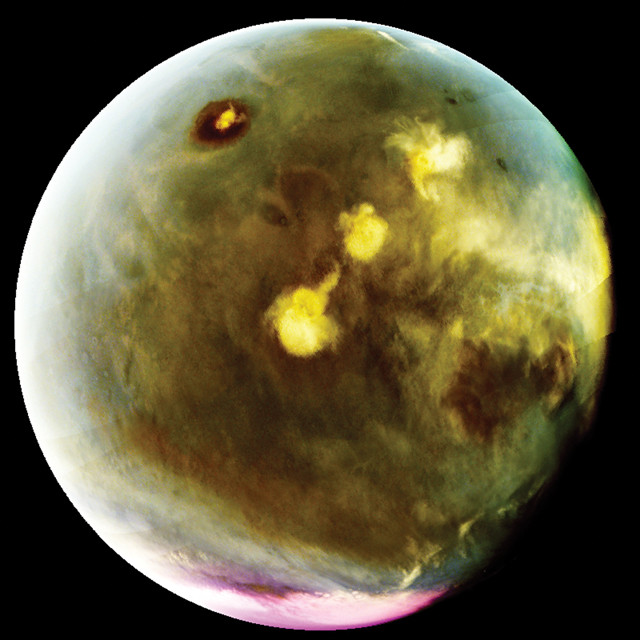
by Timothy Oleson Wednesday, January 25, 2017

The bright spots in this ultraviolet view of Mars, assembled from images collected by the MAVEN orbiter in July, are clouds that rapidly formed over Mars' largest volcanic peaks. Credit: NASA/MAVEN/University of Colorado.
With two rovers patrolling the surface of Mars, six spacecraft orbiting above it, and scientists here on Earth studying the Red Planet from afar, new findings are announced often. Here are a few of the latest updates.
The new images also provide the first views of nitric oxide-generated “nightglow” on Mars — a phenomenon hypothesized to occur there in which night skies glow slightly even without any external light — which should help scientists visualize wind patterns. Other recent observations by the orbiter, which on Oct. 3, 2016, marked one Mars year in orbit (one Mars year is a little over two Earth years), show that water loss from the planet’s atmosphere to space — measured as hydrogen escape — peaks when Mars is closest to the sun and ebbs when its orbit takes it farther away. The periodic difference in loss rate varies by a factor of 10. “Now that we know such large changes occur, we think of hydrogen escape from Mars less as a slow and steady leak and more as an episodic flow — rising and falling with season and perhaps punctuated by strong bursts,” said Michael Chaffin of CU-Boulder in a statement.
Don Hood, a graduate student at Louisiana State University, and colleagues used geochemical data collected over Thaumasia by Mars Odyssey’s Gamma Ray Spectrometer along with geologic and mineralogic observations of the area to piece together an outline of the area’s evolution through Mars’ geologic history. Based in part on trends in elemental composition across the region — decreased abundances of potassium and thorium and increased silica from east to west, for example — “this environment was most likely shaped by a series of volcanic events that continually erupted from a changing mantle composition,” Hood said in a statement. The team found no evidence, however, of widespread salt deposits in Thaumasia, challenging a previous hypothesis that much of the region had been shaped by an enormous salt-lubricated landslide.
© 2008-2021. All rights reserved. Any copying, redistribution or retransmission of any of the contents of this service without the expressed written permission of the American Geosciences Institute is expressly prohibited. Click here for all copyright requests.